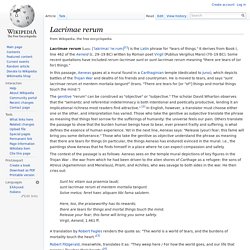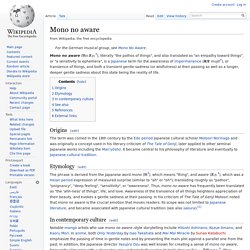

Lacrimae rerum. Lacrimae rerum (Latin: [ˈlakrimai ˈreːrum][1]) is the Latin phrase for "tears of things.

" It derives from Book I, line 462 of the Aeneid (c. 29–19 BC) written by Roman poet Virgil (Publius Vergilius Maro) (70–19 BC). Some recent quotations have included rerum lacrimae sunt or sunt lacrimae rerum meaning "there are tears of (or for) things. " The genitive "rerum" can be construed as "objective" or "subjective. " The scholar David Wharton observes that the "semantic and referential indeterminacy is both intentional and poetically productive, lending it an implicational richness most readers find attractive.
" In English, however, a translator must choose either one or the other, and interpretation has varied. A translation by Robert Fagles renders the quote as: "The world is a world of tears, and the burdens of mortality touch the heart Robert Fitzgerald, meanwhile, translates it as: "They weep here / For how the world goes, and our life that passes \ Touches their hearts. Weltschmerz. Weltschmerz (from the German, meaning world-pain or world-weariness, pronounced [ˈvɛltʃmɛɐ̯ts]) is a term coined by the German author Jean Paul Richter and denotes the kind of feeling experienced by someone who understands that physical reality can never satisfy the demands of the mind. This kind of world view was widespread among several romantic authors such as Lord Byron, Giacomo Leopardi, François-René de Chateaubriand, Alfred de Musset, Nikolaus Lenau, Hermann Hesse, and Heinrich Heine. Mono no aware. Mono no aware (物の哀れ?)

, literally "the pathos of things", and also translated as "an empathy toward things", or "a sensitivity to ephemera", is a Japanese term for the awareness of impermanence (無常, mujō?) , or transience of things, and both a transient gentle sadness (or wistfulness) at their passing as well as a longer, deeper gentle sadness about this state being the reality of life. Origins[edit] The term was coined in the 18th century by the Edo period Japanese cultural scholar Motoori Norinaga and was originally a concept used in his literary criticism of The Tale of Genji, later applied to other seminal Japanese works including the Man'yōshū.
It became central to his philosophy of literature and eventually to Japanese cultural tradition. Etymology[edit] The phrase is derived from the Japanese word mono (物?) In contemporary culture[edit] Wabi-sabi. A Japanese tea house which reflects the wabi-sabi aesthetic in Kenroku-en (兼六園) Garden Wabi-sabi (侘寂?)

Represents a comprehensive Japanese world view or aesthetic centered on the acceptance of transience and imperfection. Mottainai. Mottainai (もったいない? , [mottainai]) is a Japanese term conveying a sense of regret concerning waste.[1] The expression "Mottainai! " can be uttered alone as an exclamation when something useful, such as food or time, is wasted, meaning roughly "what a waste! " or "Don't waste. "[2] In addition to its primary sense of "wasteful", the word is also used to mean "impious; irreverent" or "more than one deserves".[3] Mottainai is an old Buddhist word, which has ties "with the Shinto idea that objects have souls Usage and translation[edit] Mottainai in Japanese refers to more than just physical waste (resources).
As an exclamation ("mottainai! ") History[edit] Origins[edit] In ancient Japanese, mottainai had various meanings, including a sense of gratitude mixed with shame for receiving greater favor from a superior than is properly merited by one's station in life.[1] Memento mori. Earthly Vanity and Divine Salvation by Hans Memling.

This triptych contrasts earthly beauty and luxury with the prospect of death and hell. The outer panels of Rogier van der Weyden's Braque Triptych shows the skull of the patron displayed in the inner panels. The bones rest on a brick, a symbol of his former industry and achievement.[1] Memento mori (Latin: "remember (that you have) to die"[2]) is the medieval Latin theory and practice of reflection on mortality, especially as a means of considering the vanity of earthly life and the transient nature of all earthly goods and pursuits.
It is related to the ars moriendi ("The Art of Dying") and related literature. In art, memento mori are artistic or symbolic reminders of mortality.[2] In the European Christian art context, "the expression... developed with the growth of Christianity, which emphasized Heaven, Hell, and salvation of the soul in the afterlife Historic usage[edit] Classical[edit] Europe — Medieval through Victorian[edit]